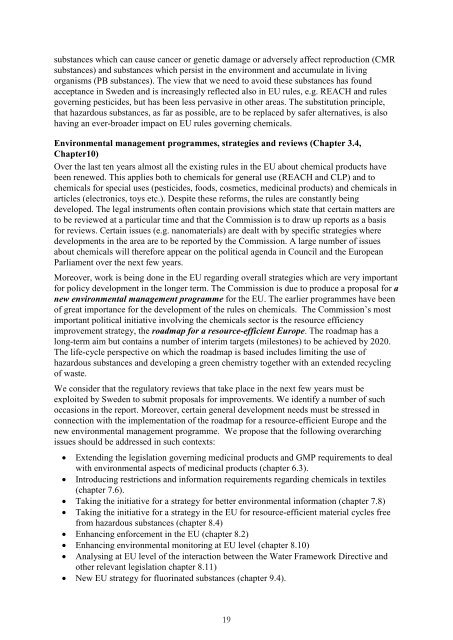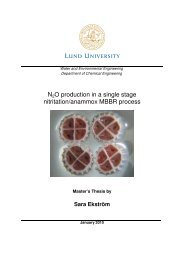Bättre EU-regler för en giftfri miljö - Kemikalieinspektionen
Bättre EU-regler för en giftfri miljö - Kemikalieinspektionen
Bättre EU-regler för en giftfri miljö - Kemikalieinspektionen
Create successful ePaper yourself
Turn your PDF publications into a flip-book with our unique Google optimized e-Paper software.
substances which can cause cancer or g<strong>en</strong>etic damage or adversely affect reproduction (CMR<br />
substances) and substances which persist in the <strong>en</strong>vironm<strong>en</strong>t and accumulate in living<br />
organisms (PB substances). The view that we need to avoid these substances has found<br />
acceptance in Swed<strong>en</strong> and is increasingly reflected also in <strong>EU</strong> rules, e.g. REACH and rules<br />
governing pesticides, but has be<strong>en</strong> less pervasive in other areas. The substitution principle,<br />
that hazardous substances, as far as possible, are to be replaced by safer alternatives, is also<br />
having an ever-broader impact on <strong>EU</strong> rules governing chemicals.<br />
Environm<strong>en</strong>tal managem<strong>en</strong>t programmes, strategies and reviews (Chapter 3.4,<br />
Chapter10)<br />
Over the last t<strong>en</strong> years almost all the existing rules in the <strong>EU</strong> about chemical products have<br />
be<strong>en</strong> r<strong>en</strong>ewed. This applies both to chemicals for g<strong>en</strong>eral use (REACH and CLP) and to<br />
chemicals for special uses (pesticides, foods, cosmetics, medicinal products) and chemicals in<br />
articles (electronics, toys etc.). Despite these reforms, the rules are constantly being<br />
developed. The legal instrum<strong>en</strong>ts oft<strong>en</strong> contain provisions which state that certain matters are<br />
to be reviewed at a particular time and that the Commission is to draw up reports as a basis<br />
for reviews. Certain issues (e.g. nanomaterials) are dealt with by specific strategies where<br />
developm<strong>en</strong>ts in the area are to be reported by the Commission. A large number of issues<br />
about chemicals will therefore appear on the political ag<strong>en</strong>da in Council and the European<br />
Parliam<strong>en</strong>t over the next few years.<br />
Moreover, work is being done in the <strong>EU</strong> regarding overall strategies which are very important<br />
for policy developm<strong>en</strong>t in the longer term. The Commission is due to produce a proposal for a<br />
new <strong>en</strong>vironm<strong>en</strong>tal managem<strong>en</strong>t programme for the <strong>EU</strong>. The earlier programmes have be<strong>en</strong><br />
of great importance for the developm<strong>en</strong>t of the rules on chemicals. The Commission’s most<br />
important political initiative involving the chemicals sector is the resource effici<strong>en</strong>cy<br />
improvem<strong>en</strong>t strategy, the roadmap for a resource-effici<strong>en</strong>t Europe. The roadmap has a<br />
long-term aim but contains a number of interim targets (milestones) to be achieved by 2020.<br />
The life-cycle perspective on which the roadmap is based includes limiting the use of<br />
hazardous substances and developing a gre<strong>en</strong> chemistry together with an ext<strong>en</strong>ded recycling<br />
of waste.<br />
We consider that the regulatory reviews that take place in the next few years must be<br />
exploited by Swed<strong>en</strong> to submit proposals for improvem<strong>en</strong>ts. We id<strong>en</strong>tify a number of such<br />
occasions in the report. Moreover, certain g<strong>en</strong>eral developm<strong>en</strong>t needs must be stressed in<br />
connection with the implem<strong>en</strong>tation of the roadmap for a resource-effici<strong>en</strong>t Europe and the<br />
new <strong>en</strong>vironm<strong>en</strong>tal managem<strong>en</strong>t programme. We propose that the following overarching<br />
issues should be addressed in such contexts:<br />
• Ext<strong>en</strong>ding the legislation governing medicinal products and GMP requirem<strong>en</strong>ts to deal<br />
with <strong>en</strong>vironm<strong>en</strong>tal aspects of medicinal products (chapter 6.3).<br />
• Introducing restrictions and information requirem<strong>en</strong>ts regarding chemicals in textiles<br />
(chapter 7.6).<br />
• Taking the initiative for a strategy for better <strong>en</strong>vironm<strong>en</strong>tal information (chapter 7.8)<br />
• Taking the initiative for a strategy in the <strong>EU</strong> for resource-effici<strong>en</strong>t material cycles free<br />
from hazardous substances (chapter 8.4)<br />
• Enhancing <strong>en</strong>forcem<strong>en</strong>t in the <strong>EU</strong> (chapter 8.2)<br />
• Enhancing <strong>en</strong>vironm<strong>en</strong>tal monitoring at <strong>EU</strong> level (chapter 8.10)<br />
• Analysing at <strong>EU</strong> level of the interaction betwe<strong>en</strong> the Water Framework Directive and<br />
other relevant legislation chapter 8.11)<br />
• New <strong>EU</strong> strategy for fluorinated substances (chapter 9.4).<br />
19















